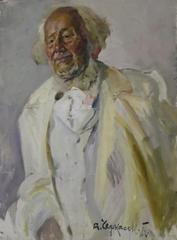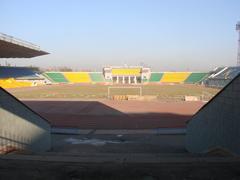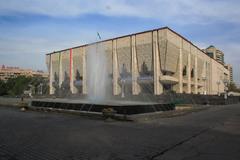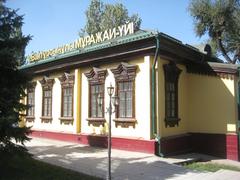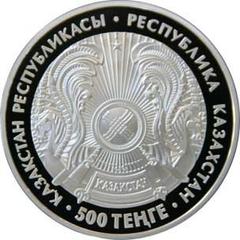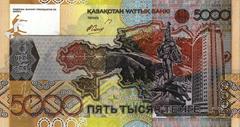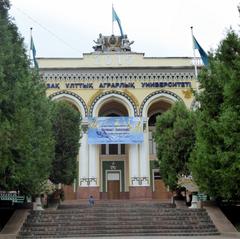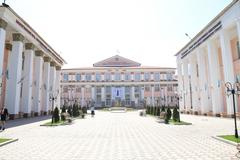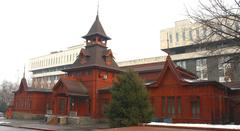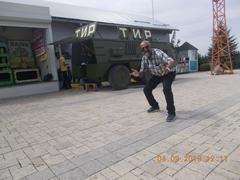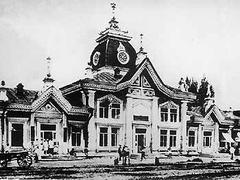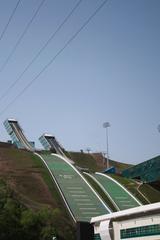Raiymbek Batyr Visiting Hours, Tickets, and Almaty Historical Sites Guide
Date: 04/07/2025
Introduction
Raiymbek Batyr stands as a legendary figure in Kazakh history, celebrated for his valor, strategic brilliance, and enduring spiritual impact. Visitors to Almaty can honor his memory at the Raiymbek Batyr Mausoleum and Monument, both of which are significant landmarks offering deep insights into Kazakhstan’s heroic past and cultural heritage. This detailed guide provides comprehensive information on Raiymbek Batyr’s historical legacy, visiting hours, ticket policies, accessibility, cultural etiquette, and recommendations for nearby attractions—helping you plan a memorable and enriching journey through Almaty’s historical sites (e-history.kz, wikipedia.org).
Table of Contents
- Introduction
- Historical Background of Raiymbek Batyr
- Visitor Information for Raiymbek Batyr Mausoleum
- Architectural Features and Site Layout
- Cultural and Spiritual Significance
- Nearby Attractions in Almaty
- Cultural Insights and Local Customs
- Safety and Responsible Tourism
- FAQs
- Conclusion and Call to Action
- Official Sources and Further Reading
Historical Background of Raiymbek Batyr
Early Life and Ancestry
Raiymbek Batyr was born in 1705 in the Almaty region, a member of the Alban tribe of the Elder Zhuz—one of the prominent divisions in Kazakh society. His grandfather, Khangeldy, was a renowned leader and diplomat who played a pivotal role in Russian-Kazakh relations, even visiting St. Petersburg in 1734 (e-history.kz). Growing up amid the turbulence of the early 18th century, Raiymbek was instilled with a strong sense of duty to protect his homeland.
Rise to Prominence and the Title of Batyr
Bestowed the title “batyr”—meaning warrior—at just 17, Raiymbek distinguished himself through acts of courage and military skill. The term “batyr” itself signifies outstanding valor and leadership, and Raiymbek quickly earned a reputation for his command in battle and his deep care for his people (wikipedia.org).
The Dzungar Invasion and the “Great Disaster”
Raiymbek’s era was marked by the Dzungar invasions, a catastrophic period for the Kazakhs known as the “Great Disaster” (Aktaban Shubyryndy). The Dzungar onslaught threatened Kazakh territories and cultural identity, but Raiymbek, alongside fellow batyrs, led defensive campaigns that saved thousands and preserved the nation’s heritage (e-history.kz).
Military Campaigns and Strategic Achievements
Raiymbek led critical military campaigns to liberate regions such as Sögeti, Oyrantöbe, and Zhetysu. His tactics favored strategic victories with minimal losses, and he played a decisive role in the eventual defeat and expulsion of the Dzungars from southeastern Kazakhstan (wikipedia.org). Working with notable leaders like Abylai Khan and Kabanbay Batyr, Raiymbek helped shape the borders and future of the Kazakh state (e-history.kz).
Diplomatic Influence and Relations with Russia
Beyond the battlefield, Raiymbek demonstrated diplomacy by negotiating with both Chinese and Russian authorities. Following his grandfather’s diplomatic path, he petitioned Empress Anna Ivanovna for support, ultimately facilitating the integration of the Senior Zhuz into the Russian sphere (wikipedia.org).
Spiritual Legacy and Sainthood
Raiymbek is venerated as an “auliye” (saint) in Kazakh tradition, believed to possess spiritual insight and clairvoyance (iie.kz). According to legend, he asked to be buried where his white camel would stop—a place now marked by his mausoleum in Almaty, which has become a site of pilgrimage (welcome.kz).
Enduring Memory and Cultural Impact
Raiymbek’s legacy resonates in Kazakh culture, commemorated through literature, poetry, and monuments. His life is celebrated in works like M. Makataev’s poem “Rayimbek, Rayimbek!” and S. Kumisbayuly’s historical account “Rayimbek batyr. History, Personality, Time” (iie.kz). Numerous public sites and administrative districts in Almaty bear his name, and his 300th anniversary was marked with national celebrations (wikipedia.org).
Visitor Information for Raiymbek Batyr Mausoleum
Visiting Hours and Tickets
- Hours: Open daily from 9:00 AM to 6:00 PM.
- Tickets: Free admission; donations for site maintenance are welcome.
How to Get There
The mausoleum is located near the Central Cemetery on Raiymbek Avenue in Almaty. It is accessible by public transit, taxi, or on foot from the city center. The nearby Raiymbek Batyr Metro station provides convenient access (mywanderlust.pl).
Facilities and Accessibility
The mausoleum features wheelchair-accessible pathways, benches, informational plaques in multiple languages, and shaded areas. Public restrooms and cafes are available nearby.
Special Events and Photographic Spots
Cultural ceremonies and special events are held on national holidays and Raiymbek Batyr’s anniversaries. The mausoleum’s yurt-inspired architecture and the statue of the white camel are popular for photographs.
Architectural Features and Site Layout
The Raiymbek Batyr Mausoleum, completed in 1994, blends modern design with traditional symbolism. The pointed arch resembles a yurt, embodying Kazakh nomadic heritage and unity, while the white marble and granite structure conveys dignity and purity. The mausoleum is surrounded by landscaped gardens and a public plaza, offering a peaceful setting for reflection and ceremonies.
Visual suggestion: Include images of the mausoleum’s architecture and events, with alt text such as “Raiymbek Batyr Mausoleum architecture.”
Cultural and Spiritual Significance
The mausoleum is not only a memorial but also a spiritual center. Many Kazakhs visit to seek blessings, healing, or inspiration. Rituals often include tying prayer ribbons to trees and lighting candles, reflecting a blend of Islamic and pre-Islamic traditions. National commemorative ceremonies feature poetry, music, and speeches (Astana Times).
Nearby Attractions in Almaty
- Green Bazaar (Zelyony Bazaar): Traditional market offering local foods and crafts.
- Panfilov Park & Zenkov Cathedral: Historic park and wooden cathedral, central to Almaty’s culture.
- Central Mosque of Almaty: One of the largest mosques in Central Asia.
The mausoleum’s central location makes it easy to combine with visits to these and other notable sites (mywanderlust.pl).
Cultural Insights and Local Customs
Engage with local traditions by participating in prayer rituals, listening to oral histories, or joining guided tours. Modest dress and quiet reflection are encouraged, especially during ceremonies.
Safety and Responsible Tourism
The mausoleum is located in a safe and well-patrolled area. Visitors should respect the sanctity of the site, avoid littering, and support local vendors. Almaty is generally considered safe for tourists, but standard precautions with valuables are advised (mywanderlust.pl).
Raiymbek Batyr Monument in Ile-Alatau National Park
Overview
Situated in Ile-Alatau National Park, the Raiymbek Batyr Monument is a grand tribute, featuring a dynamic statue capturing the warrior’s strength and resilience (Evendo). The monument is set within landscaped grounds with scenic mountain vistas, ideal for both cultural appreciation and nature walks.
Visiting Hours & Tickets
- Hours: Open year-round, no specific restrictions.
- Tickets: No admission fee.
Getting There
- By Car: Accessible via Al-Farabi Avenue toward Medeu District; parking available.
- By Public Transport: Bus 12 to Medeu, then a short taxi ride or 30-minute walk.
- By Taxi/Ride-share: Yandex.Taxi and Bolt are available, with reasonable fares.
Facilities
Basic amenities include benches, walking paths, and parking. Nearby Almaty provides restaurants and restrooms.
Best Time to Visit
July offers pleasant temperatures (14–27°C/57–81°F) and frequent cultural events (Wanderlog).
Etiquette
Photography is welcome; be respectful during ceremonies. The terrain is mostly accessible, but those with mobility issues should take care.
Combine with Other Activities
Visitors can explore hiking trails, Medeu ice rink, Shymbulak ski resort, and Almaty’s city center attractions.
Practical Visitor Tips
- Dress modestly and bring layers for changing weather.
- Use public transport or city taxis for convenience.
- Carry a translation app for reading signage.
- Guided tours are recommended for historical context.
- Souvenirs and refreshments are readily available nearby.
Frequently Asked Questions (FAQ)
Q: What are the Raiymbek Batyr Mausoleum visiting hours?
A: Daily from 9:00 AM to 6:00 PM.
Q: Is there an entrance fee?
A: No, admission is free.
Q: Are guided tours available?
A: Yes, arrange through the visitor center or local agencies.
Q: How do I reach the mausoleum and monument from Almaty?
A: Both sites are accessible by public transport, taxi, or ride-share services.
Q: Are the sites wheelchair accessible?
A: Yes, both feature accessible pathways, but some terrain at the monument may be uneven.
Q: Can I take photos?
A: Photography is allowed; drone use requires permission.
Conclusion and Call to Action
The Raiymbek Batyr Mausoleum and Monument offer a profound connection to Kazakhstan’s rich heritage, blending historical education, spiritual reflection, and cultural engagement. With free and open access, accessible facilities, and a central location near other city landmarks, these sites are a must-visit for anyone exploring Almaty.
To enhance your experience, download the Audiala mobile app for interactive maps, audio guides, and updates on cultural events. Explore related articles for in-depth insights on Kazakh history, and follow us on social media for the latest visitor tips and travel inspiration.
Official Sources and Further Reading
- Raiymbek Batyr: Historical Legacy and Visitor Guide (e-history.kz)
- Raiymbek Batyr - Wikipedia
- Raiymbek Batyr Mausoleum - Wikipedia
- Evendo: Raiymbek Batyr Monument Guide
- Wanderlog: Almaty in July
- mywanderlust.pl: Reasons to Visit Almaty
- Astana Times: Kazakh Batyrs Historical Legacy
- iie.kz: Raiymbek Batyr and Spiritual Legacy
- welcome.kz: Raiymbek Batyr Mausoleum Visitor Guide
